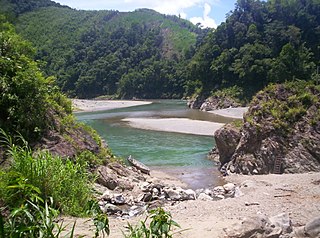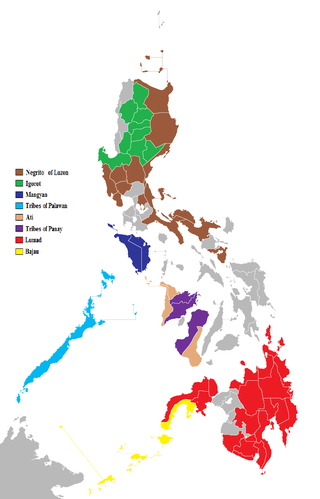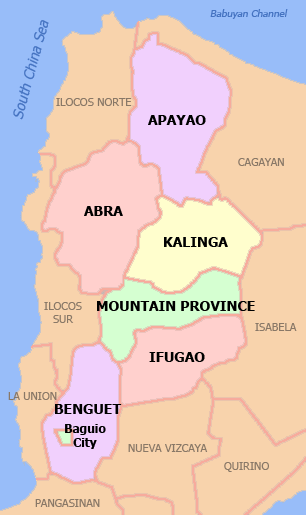Related Research Articles

Mountain Province is a landlocked province of the Philippines in the Cordillera Administrative Region in Luzon. Its capital is Bontoc while Bauko is the largest municipality. Mountain Province was formerly referred to as Mountain in some foreign references. The name is usually shortened by locals to Mt. Province.

Apayao, officially the Province of Apayao, is a landlocked province in the Philippines in the Cordillera Administrative Region in Luzon. Kabugao serves as its capital. The provincial capitol and its associated offices are located at the New Government Center in Luna.

Kalinga, officially the Province of Kalinga, is a landlocked province in the Philippines situated within the Cordillera Administrative Region in Luzon. Its capital is Tabuk and borders Mountain Province to the south, Abra to the west, Isabela to the east, Cagayan to the northeast, and Apayao to the north. Kalinga and Apayao are the result of the 1995 partitioning of the former province of Kalinga-Apayao which was seen to better service the respective needs of the various indigenous peoples in the area.

Kalinga-Apayao was a province of the Philippines in the Cordillera Administrative Region in the island of Luzon. It was formed, along with Benguet, Ifugao, and the new Mountain Province, from the earlier Mountain Province, with the passage of Republic Act No. 4695 in 1966. The said law was amended by RA No. 7878 in 1995, which divided the province into two new ones, Kalinga and Apayao.

The Cordillera Administrative Region, also known as the Cordillera Region and Cordillera, is an administrative region in the Philippines, situated within the island of Luzon. It is the only landlocked region in the archipelago, bordered by the Ilocos Region to the west and southwest, and by the Cagayan Valley Region to the north, east, and southeast.

The indigenous peoples of the Cordillera in northern Luzon, Philippines, often referred to by the exonym Igorot people, or more recently, as the Cordilleran peoples, are an ethnic group composed of nine main ethnolinguistic groups whose domains are in the Cordillera Mountain Range, altogether numbering about 1.8 million people in the early 21st century.

Sagada, officially the Municipality of Sagada is a 5th class municipality in the province of Mountain Province, Philippines. According to the 2020 census, it has a population of 11,510 people.

The Kalinga people are an indigenous ethnic group whose ancestral domain is in the Cordillera Mountain Range of the northern Philippines. They are mainly found in Kalinga province which has an area of 3,282.58 sq. km. Some of them, however, already migrated to Mountain Province, Apayao, Cagayan, and Abra. The Kalinga numbered 163,167 as of 2010.

The cultural achievements of pre-colonial Philippines include those covered by the prehistory and the early history (900–1521) of the Philippine archipelago's inhabitants, the pre-colonial forebears of today's Filipino people. Among the cultural achievements of the native people's belief systems, and culture in general, that are notable in many ethnic societies, range from agriculture, societal and environmental concepts, spiritual beliefs, up to advances in technology, science, and the arts.

The indigenous peoples of the Philippines are ethnolinguistic groups or subgroups that maintain partial isolation or independence throughout the colonial era, and have retained much of their traditional pre-colonial culture and practices.
Eduardo Masferré was a Filipino-Catalan photographer who made important documentary reports about the lifestyle of native people in the region of the Cordillera in the Philippines at the middle of 20th century. He is regarded as the Father of Philippine photography.
The Chico River Dam Project was a proposed hydroelectric power generation project involving the Chico River on the island of Luzon in the Philippines that locals, notably the Kalinga people, resisted because of its threat to their residences, livelihood, and culture. The project was shelved in the 1980s after public outrage in the wake of the murder of opposition leader Macli-ing Dulag. It is now considered a landmark case study concerning ancestral domain issues in the Philippines.
The Cordillera People's Liberation Army (CPLA) was a militant organization based in the Cordillera region in the Philippines founded by Conrado Balweg.

Macli-ing Dulag (customarily referred to by his first name, also spelled Macliing or Macli'ing was a pangat of the Butbut tribe of Kalinga province in the Philippines. He is best known as one of the leaders of the opposition to the Chico River Dam Project, which led to his assassination by armed forces under the command of then-president Ferdinand Marcos.
The Kalinga Ethnoarchaeological Project (KEP), based in the Cordillera Mountains of the Philippines, was one of the longest-running ethnoarchaeological projects in the world. It was initiated by William Longacre, professor at the University of Arizona, in 1973. Lasting for almost 20 years, research focused on pottery production, use, exchange, and discard, and was carried out by Longacre and his team of Kalinga assistants, archaeology students, and colleagues.

The Cordillera autonomy movement in the Philippines refers to the campaign for greater autonomy for the Cordilleras.
Religious sector opposition against the dictatorship of President Ferdinand Marcos included leaders and workers belonging to different beliefs and denominations.

Sagada coffee, also known as Sagada arabica, is a single-origin coffee varietal grown in Sagada in the Cordillera highlands of the northern Philippines. It belongs to the species Coffea arabica, of the Typica variety.
The Mount Data Peace Accord is a peace deal signed between the government of the Philippines and the Cordillera People's Liberation Army on September 13, 1986, ending hostilities due to the latter's campaign for greater autonomy for the Cordillera region.
Indigenous people’s resistance against the Marcos dictatorship varied from case to case among the various indigenous peoples of the Philippines. The most documented cases are the various resistance movements towards the Marcos administration’s appropriation of indigenous lands, particularly in the case of the Chico River Dam Project and the Manila Water Supply III project on the Kaliwa River watershed, and the birth of the various separatist groups and their coalescing into the Moro conflict in the wake of news about the Jabidah Massacre.
References
- ↑ Kusumā Sanitwong Na ʻAyutthayā; et al. (2005). Ethnic Conflicts in Southeast Asia. Institute of Southeast Asian Studies. p. 141. ISBN 981-230-340-5 . Retrieved 2008-09-16.
- ↑ Sumeg-ang, Arsenio (2005). "5 The Kalingas". Ethnography of the Major Ethnolinguistic Groups in the Cordillera. Quezon City: New Day Publishers. pp. 127–130. ISBN 9789711011093.
- ↑ Rowthorn, Chris; Monique Choy; Michael Grosberg (2003). Philippines . Lonely Planet. p. 30. ISBN 1-74059-210-7 . Retrieved 2008-09-16.
bodong kalinga.
- 1 2 Masferré, Eduardo; Jill Gale De Villa (1999). A Tribute to the Philippine Cordillera. Asiatype, Inc. ISBN 971-91712-0-0 . Retrieved 2008-09-16.